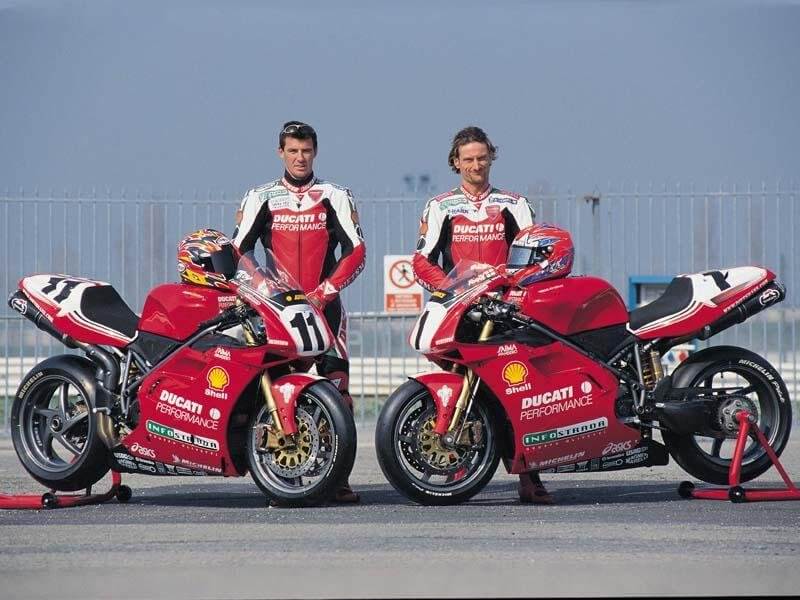Winning Races On a Ducati 916 (1994 – 1998)

The Japanese bikes of the era may be light, pushed on by powerful engines, but they were had started growing bigger in size. Sit on any one of those 750cc Japanese sportbikes and there was no disguising the widths of the tank, seat and bodywork. Riders in World Superbike racing found it difficult to move from side to side.
Inline-Fours also have a handicap, since they made most of their power up high in the rev range. Ducati’s V-Twin engine, on the other hand, had more grunt off corners. Tracks in those days had more turns and were narrower, unlike subsequently new ones which featured long straights followed by hard-braking zones as they are shared with Formula 1 racing.
Additionally, the 90-degree V-Twin’s 270/450-degree uneven firing order delivered better rear tyre grip under hard acceleration compared to an inline-Four’s. (Honda went on to develop their Big Bang 500cc GP engine for this same reason as does Yamaha with its current YZF-M1.) Traction control wasn’t even a mad scientist’s idea at the time.
That’s not all. Ducati had steadfastly stuck to their persistence in using the chrome-moly steel trellis frame, when the competition was beating themselves senseless over aluminum frames. The Ducati’s stiff frame had little flex consequently allowing to riders to accelerate and brake harder, and made sure the bike didn’t tie itself in knots when fitted with sticky racing rubber.

Thus the Ducati 851 and 888 started to beat their Asian opponents. However, although they were both beautiful in their own right, they looked somewhat similar to their contemporaries: Square headlights, wider bodywork, blunt and straight lines.
Until Massino Tamburini, head of the TA in Bimota, designed the 916. Word has it that he was inspired by the oval-pistoned Honda NR750 with its single-sided swingwarm, underseat exhaust canisters and dual headlights.
Since the V-Twin engine places its cylinders fore and aft, that gave him the opportunity to create a machine that’s slim at the waistline, for the look of a curvy woman when viewed from the top. The 916 signaled a new age in sportbike packaging where every component was crammed into a bike that’s slightly larger than a 250.
Such design transferred to the ability for riders to tuck in tighter, and made hanging off as well side-to-side transitions much easier.
The 916 and its subsequent variants went on to dominate World Superbike racing, winning 6 championships, with four of those going to ‘King’ Carl Fogarty, to become the most successful rider in the series. It took Honda, Ducati’s biggest rival in WSBK to finally land a title in the hands of John Kocinski on the RVF750 (RC45) and later with Colin Edwards (years 2000 and 2002) on the RVT1000 (RC51) SP-1 and SP-2 V-Twin. Ducati won so many times that WSBK was derided as “The Ducati Cup.”
The 916’s design could only be interpreted as sexy. It was the equivalent of a Ferrari on two wheels. It starred in movies, numerous superstars and soccer stars owned one, including Ewan McGregor. Lotus Elise’s designer Julian Thompson admitted that it was the 916 that inspired his creation.
Current superbikes could trace their designs to the Ducati 916: Twin oval headlamps, underseat exhausts, diminutive size.
The bike was also included in the prestigious the Art of the Motorcycle exhibition at the Guggenheim Museum.

